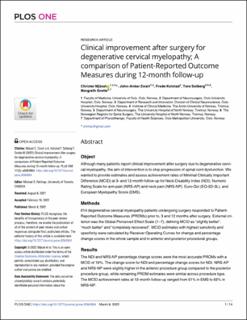| dc.contributor.author | Mjåset, Christer | |
| dc.contributor.author | Zwart, John Anker Henrik | |
| dc.contributor.author | Kolstad, Frode | |
| dc.contributor.author | Solberg, Tore | |
| dc.contributor.author | Grotle, Margreth | |
| dc.coverage.spatial | Europe | en_US |
| dc.date.accessioned | 2022-09-21T07:48:18Z | |
| dc.date.available | 2022-09-21T07:48:18Z | |
| dc.date.created | 2022-04-27T12:56:14Z | |
| dc.date.issued | 2022-03-08 | |
| dc.identifier.citation | PLOS ONE. 2022, 17 (3), 1-14. | en_US |
| dc.identifier.issn | 1932-6203 | |
| dc.identifier.uri | https://hdl.handle.net/11250/3020076 | |
| dc.description.abstract | Object: Although many patients report clinical improvement after surgery due to degenerative cervical myelopathy, the aim of intervention is to stop progression of spinal cord dysfunction. We wanted to provide estimates and assess achievement rates of Minimal Clinically Important Difference (MCID) at 3- and 12-month follow-up for Neck Disability Index (NDI), Numeric Rating Scale for arm pain (NRS-AP) and neck pain (NRS-NP), Euro-Qol (EQ-5D-3L), and European Myelopathy Score (EMS).
Methods: 614 degenerative cervical myelopathy patients undergoing surgery responded to Patient-Reported Outcome Measures (PROMs) prior to, 3 and 12 months after surgery. External criterion was the Global Perceived Effect Scale (1–7), defining MCID as “slightly better”, “much better” and “completely recovered”. MCID estimates with highest sensitivity and specificity were calculated by Receiver Operating Curves for change and percentage change scores in the whole sample and in anterior and posterior procedural groups.
Results: The NDI and NRS-NP percentage change scores were the most accurate PROMs with a MCID of 16%. The change score for NDI and percentage change scores for NDI, NRS-AP and NRS-NP were slightly higher in the anterior procedure group compared to the posterior procedure group, while remaining PROM estimates were similar across procedure type. The MCID achievement rates at 12-month follow-up ranged from 51% in EMS to 62% in NRS-NP.
Conclusion: The NDI and NRS-NP percentage change scores were the most accurate PROMs to measure clinical improvement after surgery for degenerative cervical myelopathy. We recommend using different cut-off estimates for anterior and posterior approach procedures. A MCID achievement rate of 60% or less must be interpreted in the perspective that the main goal of surgery for degenerative cervical myelopathy is to prevent worsening of the condition. | en_US |
| dc.language.iso | eng | en_US |
| dc.publisher | Public Library of Science | en_US |
| dc.relation.ispartofseries | PLOS ONE;17 (3): e0264954 | |
| dc.rights | Navngivelse 4.0 Internasjonal | * |
| dc.rights.uri | http://creativecommons.org/licenses/by/4.0/deed.no | * |
| dc.subject | Surgical medical procedures | en_US |
| dc.subject | Pain | en_US |
| dc.subject | Spinal cord | en_US |
| dc.subject | Questionnaires | en_US |
| dc.subject | Surgeons | en_US |
| dc.subject | Health care providers | en_US |
| dc.subject | Spines | en_US |
| dc.title | Clinical improvement after surgery for degenerative cervical myelopathy; A comparison of Patient-Reported Outcome Measures during 12-month follow-up | en_US |
| dc.type | Peer reviewed | en_US |
| dc.type | Journal article | en_US |
| dc.description.version | publishedVersion | en_US |
| dc.rights.holder | © 2022 Mjåset et al. | en_US |
| dc.source.articlenumber | e0264954 | en_US |
| cristin.ispublished | true | |
| cristin.fulltext | original | |
| cristin.qualitycode | 1 | |
| dc.identifier.doi | https://doi.org/10.1371/journal.pone.0264954 | |
| dc.identifier.cristin | 2019506 | |
| dc.source.journal | PLOS ONE | en_US |
| dc.source.volume | 17 | en_US |
| dc.source.issue | 3 | en_US |
| dc.source.pagenumber | 1-14 | en_US |

